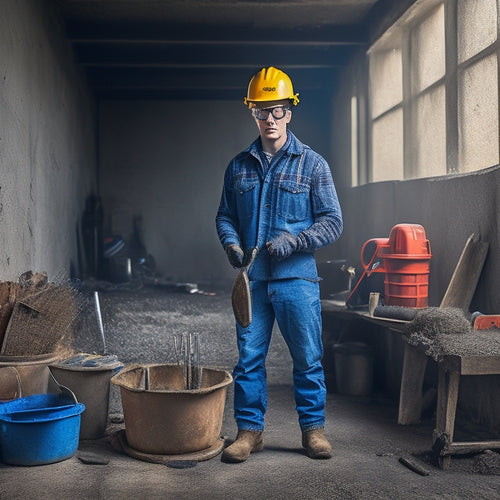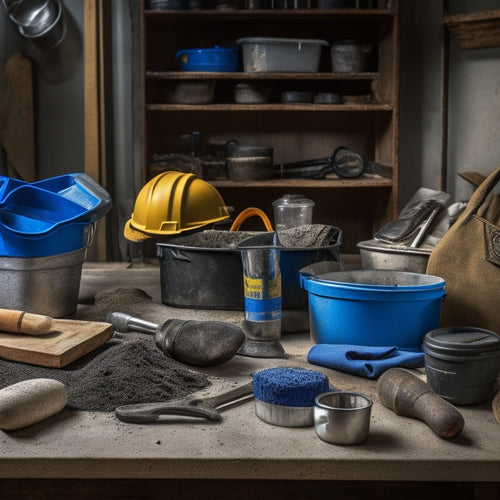
What Tools Do You Need for Self-Leveling Concrete
Share
You'll need a range of specialized tools and equipment to successfully complete a self-leveling concrete project. Start with mixing and measuring essentials like precise measuring systems, high-capacity mixers, and high-quality measuring cups or scales. Next, prepare the surface with scrapers, grinders, vacuum cleaners, and specialized devices like laser distance meters, surface profilers, and concrete scanners. For pouring and finishing, use pouring buckets, trowels, edgers, spirit levels, and smoothing trowels. Don't forget cleanup and safety gear, including brushes, scrubbers, and protective clothing. With the right tools, you'll be well on your way to achieving a professional-grade finish - and that's just the beginning of what you can accomplish.
Key Takeaways
• Mixing and measuring essentials, such as a mixing bucket and precise measuring system, ensure accurate proportions and a professional-grade finish.
• Surface preparation tools, including scrapers, grinders, and specialized devices, are necessary for removing contaminants and achieving a smooth surface.
• Pouring and finishing equipment, like pouring buckets, trowels, and edgers, help achieve a high-quality finish and accurate alignment.
• Cleanup and safety gear, including a cleanup kit, protective clothing, and steel-toed boots, are crucial for efficient cleanup and worker safety.
• Specialized concrete repair tools, such as concrete saws and demolition hammers, are necessary for making precise repairs and cuts in the concrete.
Mixing and Measuring Essentials
Set up your mixing station with a clean, level surface, a mixing bucket, and a precise measuring system to confirm accurate proportions of self-leveling concrete components. This is vital for achieving the desired consistency and strength of the final product.
When it comes to mixing techniques, you'll want to follow the manufacturer's instructions for the specific self-leveling concrete product you're using. Typically, this involves mixing the powder and liquid components in a specific sequence and ratio to achieve the ideal blend.
Measuring accuracy is critical, so invest in a high-quality measuring cup or scale to guarantee you're getting the exact proportions. Don't skip this step, as even slight variations can affect the final result.
With your mixing station set up and your measuring system in place, you'll be ready to tackle the mixing process with confidence. By following these guidelines, you'll be able to achieve a professional-grade finish and secure a strong, durable bond between the self-leveling concrete and the substrate.
Surface Preparation Tools
You'll need a range of specialized tools to prepare the surface for self-leveling concrete, including scrapers, grinders, and vacuums that can effectively remove old adhesives, dirt, and other contaminants. These tools are essential for a successful surface assessment, which involves evaluating the substrate's condition and identifying any imperfections that need to be addressed.
For substrate cleaning, you'll need a reliable vacuum cleaner that can pick up dust, dirt, and other debris. A floor scraper or grinder will also come in handy for removing old adhesives, paint, or other substances that may be stuck to the surface.
Additionally, a wire brush or steel wool can help to roughen the surface, creating a better bond between the old substrate and the new self-leveling concrete.
Remember to always follow the manufacturer's instructions when using these tools, and take necessary safety precautions to avoid injuries or damage to the substrate.
Pouring and Finishing Equipment
With the surface prepared, it's time to move on to the pouring and finishing process, which requires a distinct set of equipment designed to facilitate a smooth, even flow of self-leveling concrete and achieve a high-quality finish.
To guarantee a successful pour, you'll need the right tools for the job. Here are some essential pieces of equipment to take into account:
| Tool | Description | Purpose |
|---|---|---|
| Pouring bucket | A large, sturdy container with a handle | To transport and pour self-leveling concrete |
| Trowel | A flat, rectangular tool with a handle | To spread and smooth out the concrete |
| Edger | A long, flat tool with a handle | To create clean edges and define boundaries |
When it comes to pouring methods, you'll want to take into account factors like flow rate, temperature, and humidity to guarantee the concrete flows smoothly and evenly. Trowel techniques, such as holding the trowel at a 45-degree angle and using long, sweeping motions, can also make a big difference in achieving a high-quality finish. By using the right equipment and techniques, you'll be able to achieve a smooth, even surface that's ready for finishing.
Leveling and Smoothing Tools
Two essential tools for achieving a perfectly level and smooth surface are the spirit level and the smoothing trowel, which work in tandem to confirm accurate alignment and a flawless finish. As you work on your self-leveling concrete project, you'll rely on these tools to guarantee a professional-grade result.
When it comes to leveling and smoothing, you'll employ various techniques to achieve the desired outcome. Some of the key methods include:
-
Screeding techniques: These involve using a screed board or a straightedge to remove excess concrete and create a level surface.
-
Troweling methods: You'll use your smoothing trowel to apply pressure and smooth out the surface, removing any imperfections or air pockets.
-
Finishing strokes: These involve using long, sweeping motions to create a uniform, glossy finish.
Cleanup and Safety Gear
Every self-leveling concrete project requires a well-stocked cleanup kit and essential safety gear to protect yourself and your workspace from the hazards of working with concrete.
You'll need a variety of cleaning tools, such as stiff-bristled brushes, scrubbers, and sponges, to remove excess concrete and residue from your tools and equipment. Don't forget a good quality dustpan and broom to sweep up debris and dust.
When it comes to safety gear, you can't afford to compromise. Wear protective clothing, including gloves, safety glasses, and a dust mask, to prevent skin and eye irritation and respiratory problems. Steel-toed boots and a hard hat will also protect you from heavy objects and falling debris.
Implement proper cleanup techniques, such as rinsing your tools and equipment regularly, to prevent concrete from setting and making cleanup more difficult. Take necessary safety precautions, like cordoning off the work area and posting warning signs, to prevent accidents and injuries.
Specialized Concrete Repair Tools
When you're working with self-leveling concrete, you'll need specialized tools to repair and prepare the surface.
You'll want to familiarize yourself with concrete cutting equipment, which enables you to remove damaged or uneven sections.
Next, you'll use mixing and pumping tools to apply the self-leveling compound, and surface preparation devices to guarantee a smooth finish.
Concrete Cutting Equipment
You'll need specialized concrete cutting equipment to accurately remove damaged or deteriorated concrete sections, allowing for effective repair and restoration. This equipment is essential for making precise cuts and removing unwanted concrete, ensuring a strong bond between the old and new concrete.
To get the job done efficiently, you'll require the following concrete cutting tools:
-
Concrete saws: These powerful machines are designed to make clean cuts through concrete, making them ideal for removing damaged sections or creating joints.
-
Cutting blades: These high-performance blades are specifically designed for concrete cutting, providing a fast and efficient way to remove unwanted material.
-
Demolition hammers: These heavy-duty tools are perfect for breaking up and removing large chunks of concrete, making them a valuable addition to your concrete cutting arsenal.
Mixing and Pumping Tools
With the damaged concrete removed, it's time to prepare the new concrete mix and get it in place, which requires specialized mixing and pumping tools to guarantee a successful repair.
You'll need a high-capacity mixer that can handle the large volumes of self-leveling concrete required for the job. Look for a mixer with a robust motor and a durable drum that can withstand the rigors of heavy use.
When it comes to mixing techniques, it's important to follow the manufacturer's instructions for the specific self-leveling concrete product you're using. Overmixing or undermixing can lead to inconsistent results, so make sure you're mixing the right amount of water and concrete for the job.
Once you've mixed the concrete, you'll need a reliable pump to get it in place. Regular pump maintenance is vital to confirm the pump is functioning correctly and to prevent clogs and other issues. Make sure to clean the pump regularly and check for worn or damaged parts that need to be replaced.
With the right mixing and pumping tools, you'll be able to achieve a smooth, even finish that's necessary for a successful self-leveling concrete repair.
Surface Preparation Devices
Five specialized surface preparation devices are essential for ensuring a strong bond between the old concrete and the new self-leveling concrete. As you prepare the surface, you'll need tools that can effectively assess and modify the substrate to create an ideal environment for the new layer.
You'll need to evaluate the surface texture and perform a substrate assessment to identify any imperfections or weaknesses. To do this, you'll require:
-
A laser distance meter to measure the substrate's flatness and detect any deviations
-
A surface profiler to analyze the surface texture and identify any irregularities
-
A concrete scanner to detect any hidden defects or voids beneath the surface
These devices will help you identify areas that need repair or modification before applying the self-leveling concrete.
Frequently Asked Questions
Can I Use Self-Leveling Concrete Over Existing Ceramic Tiles?
When you're considering self-leveling concrete over existing ceramic tiles, you'll need to assess the feasibility of the installation.
You'll need to guarantee the tiles are securely fastened and the surface is level, clean, and dry.
Proper surface preparation is essential, including cleaning and degreasing the tiles.
Then, you can apply a bonding agent and follow the manufacturer's installation techniques for a successful overlay.
How Long Does Self-Leveling Concrete Take to Fully Cure?
You're itching to get back to your renovation project, but you're stuck waiting for the self-leveling concrete to cure.
Unlike a fancy dinner that's ready in an hour, self-leveling concrete takes its sweet time. The curing time can range from 24 hours to several days, depending on the product and environmental conditions.
During the drying process, the mixture transforms into a solid, durable surface.
Be patient, and let the concrete do its magic – it'll be worth the wait.
Can I Add Color or Texture to Self-Leveling Concrete?
You're wondering if you can add some flair to your self-leveling concrete. The answer is yes!
You can customize the appearance of your concrete by incorporating color additives or exploring texture options. These additives can be mixed into the concrete before pouring, allowing you to achieve a unique look that suits your design goals.
Just make sure you follow the manufacturer's instructions and recommended ratios to avoid affecting the concrete's performance.
Is Self-Leveling Concrete Suitable for Outdoor Use?
Silky smooth surfaces await, but first, you're wise to wonder if self-leveling concrete is suitable for outdoor use.
The answer lies in its outdoor durability, which is compromised if not properly prepared.
Guarantee a strong bond by meticulously executing surface preparation, including cleaning and priming the substrate.
Then, you can confidently pour self-leveling concrete, knowing it'll withstand the elements and endure for years to come.
Can I Use Self-Leveling Concrete to Fix Cracks in Walls?
You can effectively use self-leveling concrete to fix cracks in walls, providing a smooth surface for further finishing.
For successful crack repair, make certain the wall surfaces are clean, dry, and free of old adhesive or paint.
Apply a bonding agent to the crack, then pour the self-leveling concrete, feathering it out to blend with the surrounding surface.
Allow it to set, and you'll have a strong, durable repair that's ready for painting or other finishes.
Conclusion
As you stand victorious, having conquered the domain of self-leveling concrete, remember that with great power comes great responsibility.
Like Atlas, you've shouldered the weight of a perfectly level surface, and now it's time to reap the rewards.
Your arsenal of tools has transformed you into a master builder, capable of taming the most unruly of concrete.
So, go forth and create structures that would make the gods proud – or at least, pass the scrutiny of the most discerning eye.
Related Posts
-

What Tools Do I Need for Concrete Wall Repair
As you prepare for a concrete wall repair job, you'll need a variety of tools to guarantee a successful outcome. Star...
-

5 Tools Needed for Quick Fix Concrete Mixing
You'll need five essential tools to tackle a quick fix concrete mixing project efficiently. First, you'll require a s...
-

5 Best Tools for Stamping Concrete Walls
When it comes to stamping concrete walls, you'll need a range of specialized tools to achieve the desired texture and...


